Dobrze skonstruowane menu nawigacyjne jest niezbędne do kierowania odwiedzających przez Twoją witrynę WordPress i zapewnienia im łatwego dostępu do potrzebnych informacji.
Niezależnie od tego, czy tworzysz swoją pierwszą witrynę, czy próbujesz poprawić doświadczenie użytkownika na istniejącej, nauka dodawania i dostosowywania menu nawigacyjnego jest ważną umiejętnością.
WordPress posiada interfejs menu typu przeciągnij i upuść, który można wykorzystać do łatwego tworzenia menu nagłówka, menu z opcjami rozwijanymi i wielu innych.
Na przestrzeni lat stworzyliśmy różnorodne menu dla naszych różnych marek, zdobywając bezpośrednie doświadczenie w projektowaniu stylów menu. Nauczyliśmy się, jakie typy menu najlepiej sprawdzają się w różnych firmach, jakie linki i strony należy uwzględnić oraz jak zoptymalizować nawigację dla lepszego doświadczenia użytkownika.
W tym przewodniku krok po kroku pokażemy Ci, jak łatwo dodać menu nawigacyjne w WordPress.
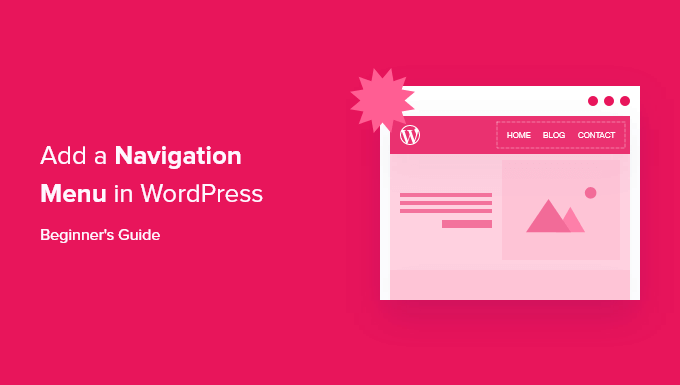
Czym jest menu nawigacyjne?
Menu nawigacyjne to lista linków wskazujących ważne obszary witryny. Zazwyczaj są one prezentowane jako poziomy pasek linków na górze każdej strony witryny WordPress.
Te menu nadają Twojej witrynie strukturę i pomagają odwiedzającym znaleźć to, czego szukają. Oto jak wygląda menu nawigacyjne na WPBeginner:

WordPress ułatwia dodawanie menu i podmenu. Możesz dodawać linki do swoich najważniejszych stron, kategorii lub tematów, wpisów na blogu, a nawet niestandardowych linków, takich jak Twój profil w mediach społecznościowych.
Dokładna lokalizacja Twojego menu będzie zależeć od Twojego motywu WordPress. Większość motywów oferuje kilka opcji, dzięki czemu możesz tworzyć różne menu, które mogą być wyświetlane w różnych miejscach.
Na przykład, większość motywów WordPress ma menu główne, które pojawia się na górze. Niektóre motywy mogą również zawierać menu drugorzędne, menu stopki lub menu nawigacyjne dla urządzeń mobilnych.
Mając to na uwadze, zobaczmy, jak możesz utworzyć niestandardowe menu nawigacyjne w WordPress.
- Tworzenie Twojego pierwszego niestandardowego menu nawigacyjnego
- Tworzenie menu rozwijanych w WordPress
- Dodawanie kategorii do menu WordPress
- Dodawanie niestandardowych linków do menu nawigacyjnych WordPress
- Edytowanie lub usuwanie elementu menu w menu nawigacyjnych WordPress
- Dodawanie menu nawigacyjnych w edytorze pełnej witryny (FSE)
- Dodawanie menu WordPress do pasków bocznych i stopek
- Dalsze możliwości menu nawigacyjnych
- Samouczek wideo
- Często zadawane pytania dotyczące menu WordPress
Tworzenie Twojego pierwszego niestandardowego menu nawigacyjnego
Aby utworzyć menu nawigacyjne, musisz przejść do strony Wygląd » Menu w swoim panelu administracyjnym WordPress.
Uwaga: Jeśli nie widzisz opcji „Wygląd » Menu” na swojej stronie, a widzisz tylko „Wygląd » Edytor”, oznacza to, że Twój motyw ma włączoną funkcję Edytora Całej Witryny (FSE). Możesz kliknąć tutaj, aby przejść do sekcji FSE poniżej.
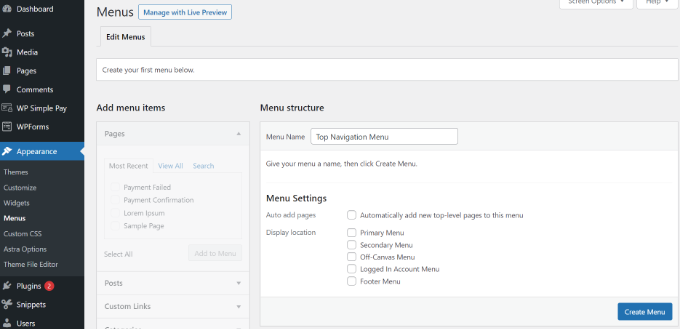
Gdy tam dotrzesz, podaj nazwę dla swojego menu, na przykład „Menu Nawigacji Górnej”, a następnie kliknij przycisk „Utwórz menu”.
Spowoduje to rozwinięcie obszaru menu i będzie wyglądać następująco:
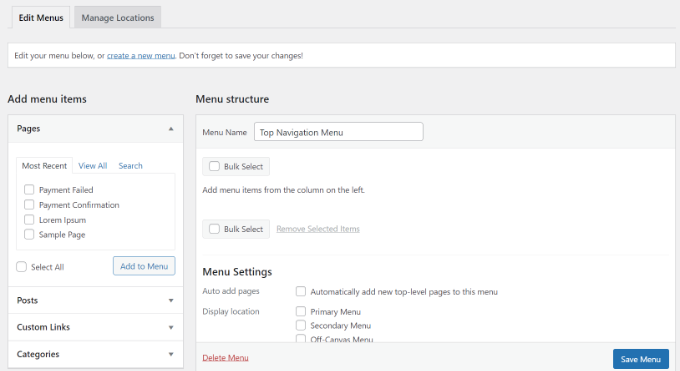
Następnie możesz wybrać strony, które chcesz dodać do menu. Możesz automatycznie dodać wszystkie nowe strony najwyższego poziomu lub wybrać konkretne strony z lewej kolumny.
Najpierw kliknij zakładkę „Zobacz wszystko”, aby zobaczyć wszystkie strony Twojej witryny. Następnie kliknij pole obok każdej ze stron, które chcesz dodać do swojego menu, a następnie kliknij przycisk „Dodaj do menu”.
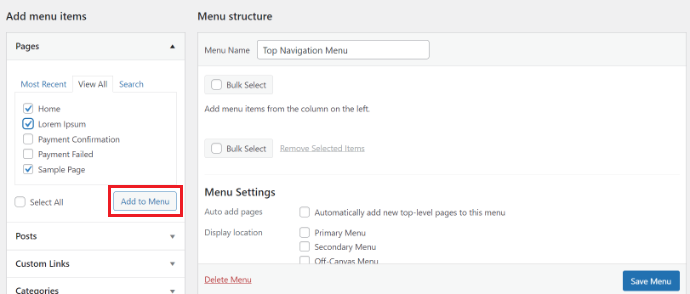
Po dodaniu stron możesz je przesuwać, przeciągając i upuszczając w sekcji „Struktura menu”.
W ten sposób możesz zmienić ich kolejność i je przearanżować.
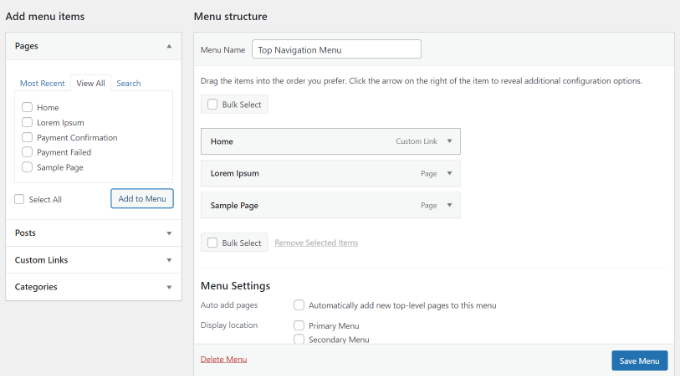
Uwaga: Wszystkie pozycje menu są wymienione w pionowej (od góry do dołu) liście w edytorze menu. Kiedy opublikujesz menu na swojej stronie, będzie ono wyświetlane pionowo lub poziomo (od lewej do prawej), w zależności od wybranej lokalizacji.
Większość motywów ma kilka różnych lokalizacji, w których można umieścić menu. W tym przykładzie używamy motywu Astra, który ma 5 różnych lokalizacji.
Po dodaniu stron do menu wybierz lokalizację, w której chcesz je wyświetlić, i kliknij przycisk „Zapisz menu”.
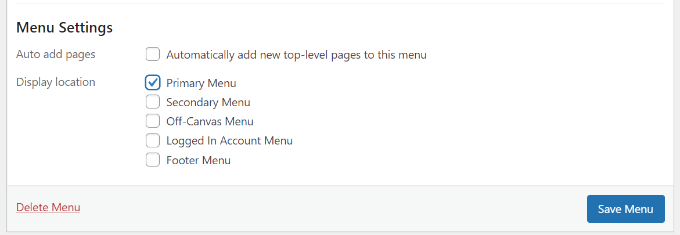
Wskazówka: Jeśli nie masz pewności, gdzie znajduje się każda lokalizacja, spróbuj zapisać menu w różnych miejscach, a następnie odwiedź swoją stronę, aby zobaczyć, jak wygląda. Prawdopodobnie nie będziesz chciał używać wszystkich lokalizacji, ale możesz chcieć użyć więcej niż jednej.
Więcej szczegółów na ten temat znajdziesz w naszym poradniku jak stworzyć pionowe menu nawigacyjne w WordPress.
Oto nasze gotowe menu na stronie:

Tworzenie menu rozwijanych w WordPress
Menu rozwijane, czasami nazywane menu zagnieżdżonymi, to menu nawigacyjne z elementami nadrzędnymi i podrzędnymi.
Kiedy najedziesz kursorem na element nadrzędny, wszystkie elementy podrzędne pojawią się pod nim w podmenu.
Aby utworzyć podmenu, przeciągnij element pod elementem nadrzędnym, a następnie przeciągnij go lekko w prawo. Zrobiliśmy to z 3 pod-elementami pod „Usługi” w naszym menu:
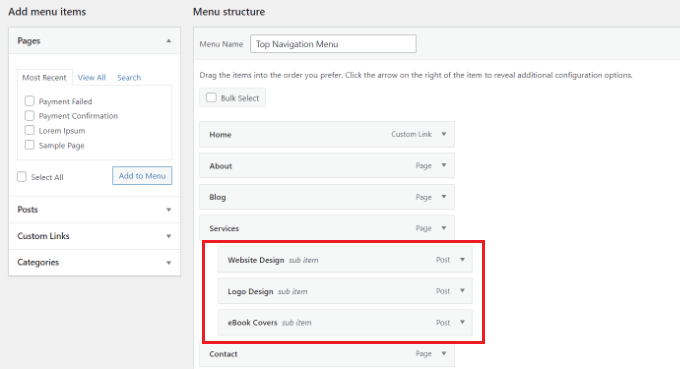
Możesz nawet dodać wiele warstw menu rozwijanych, dzięki czemu twoje podmenu może mieć własne podmenu. Może to wyglądać nieco niechlujnie, a wiele motywów nie obsługuje wielowarstwowych menu rozwijanych.
Aby uzyskać bardziej szczegółowe instrukcje, zapoznaj się z naszym poradnikiem na temat tworzenia menu rozwijanego w WordPress.
Oto podmenu na żywo na naszej stronie demonstracyjnej:
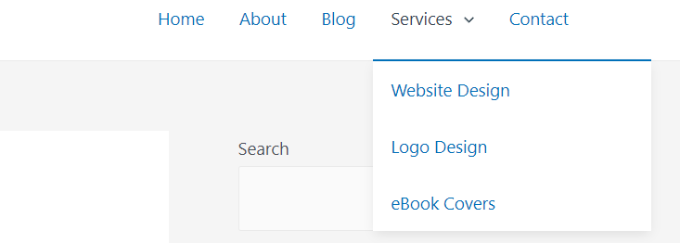
Dodawanie kategorii do menu WordPress
Jeśli używasz WordPress do prowadzenia bloga, możesz chcieć dodać swoje kategorie blogowe jako rozwijane w menu WordPress.
Robimy to na WPBeginner i mamy wiele kategorii, takich jak wiadomości, motywy, poradniki i inne.
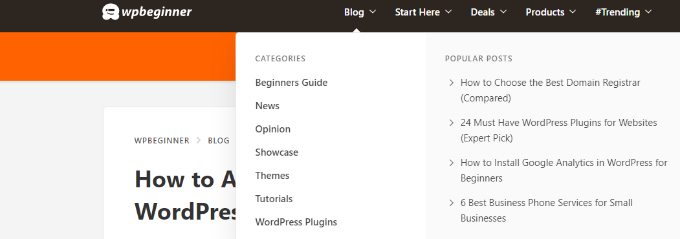
Możesz łatwo dodać kategorie do swojego menu, klikając zakładkę Kategorie po lewej stronie ekranu menu. Może być również konieczne kliknięcie zakładki „Zobacz wszystkie”, aby zobaczyć wszystkie swoje kategorie.
Po prostu wybierz kategorie, które chcesz dodać do menu, a następnie kliknij przycisk „Dodaj do menu”.
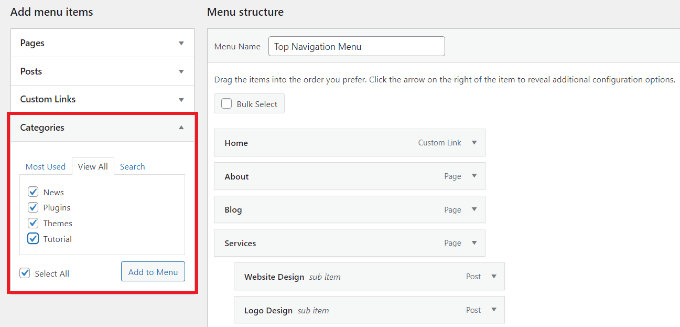
Kategorie pojawią się jako zwykłe pozycje menu na dole Twojego menu.
Następnie możesz je przeciągnąć i upuścić na miejsce. Na przykład, umieścimy wszystkie te kategorie pod pozycją menu Blog.
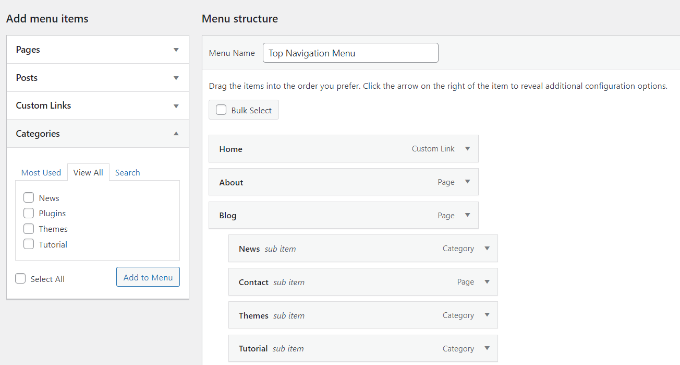
Aby uzyskać dalsze instrukcje, zapoznaj się z naszym przewodnikiem dla początkujących na temat dodawania tematów do menu nawigacyjnych WordPress.
Oto jak różne kategorie pojawiają się w menu nawigacyjnym na naszej stronie demonstracyjnej:
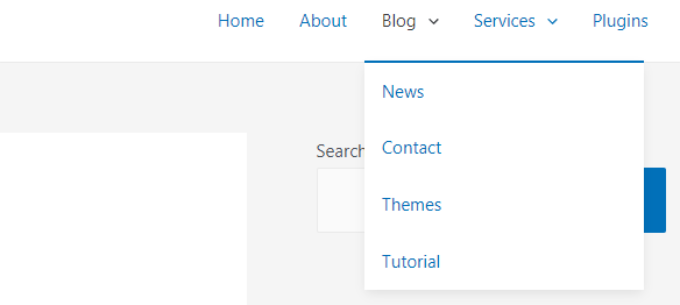
Dodawanie niestandardowych linków do menu nawigacyjnych WordPress
Oprócz kategorii i stron, WordPress ułatwia również dodawanie niestandardowych linków do menu. Możesz ich używać do linkowania do swoich profili w mediach społecznościowych, sklepu internetowego i innych posiadanych przez Ciebie stron internetowych.
Aby to zrobić, musisz użyć zakładki „Niestandardowe linki” na ekranie Menu. Po prostu dodaj link wraz z tekstem, którego chcesz użyć w swoim menu, i kliknij przycisk „Dodaj do menu”.
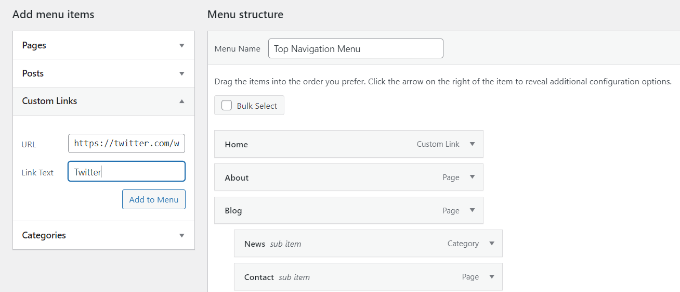
Możesz nawet wykazać się kreatywnością i dodać ikony mediów społecznościowych do swojego menu lub przyciski wezwania do działania, aby uzyskać więcej konwersji.
Edytowanie lub usuwanie elementu menu w menu nawigacyjnych WordPress
Kiedy dodajesz strony lub kategorie do swojego niestandardowego menu nawigacyjnego, WordPress używa tytułu strony lub nazwy kategorii jako tekstu linku. Możesz to zmienić, jeśli chcesz.
Każdy element menu można edytować, klikając strzałkę w dół obok niego.
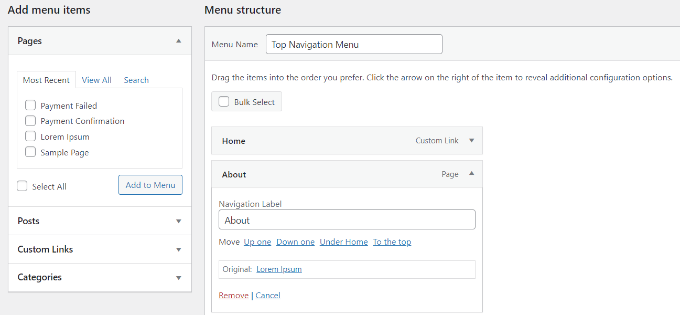
Możesz wtedy zmienić nazwę elementu menu. Możesz również kliknąć „Usuń”, aby całkowicie usunąć link z menu.
Jeśli masz problemy z interfejsem przeciągnij i upuść, możesz również przesuwać elementy menu, klikając odpowiedni link „Przenieś”.
Dodawanie menu nawigacyjnych w edytorze pełnej witryny (FSE)
Nowy edytor całych witryn pozwala na dostosowanie motywów WordPress za pomocą edytora bloków. Został wydany w WordPress 5.9 i umożliwia dodawanie różnych bloków do szablonów, aby stworzyć unikalny projekt.
Aby dodać menu nawigacyjne za pomocą edytora całego witryny, przejdź do sekcji Wygląd » Edytor z poziomu pulpitu WordPress.
W tym samouczku użyjemy domyślnego motywu Twenty Twenty-Three. Więcej szczegółów znajdziesz w naszym artykule o najlepszych motywach WordPress z edytorem całego witryny.
Gdy już znajdziesz się w edytorze, kliknij zakładkę „Nawigacja”, aby ją rozwinąć.
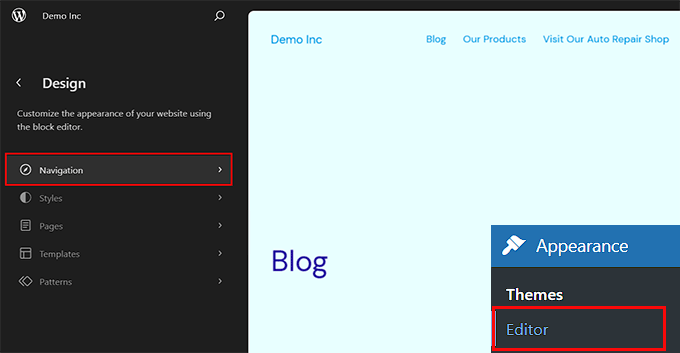
Spowoduje to otwarcie nowych ustawień w lewej kolumnie.
Stąd po prostu kliknij ikonę „Edytuj” na górze.
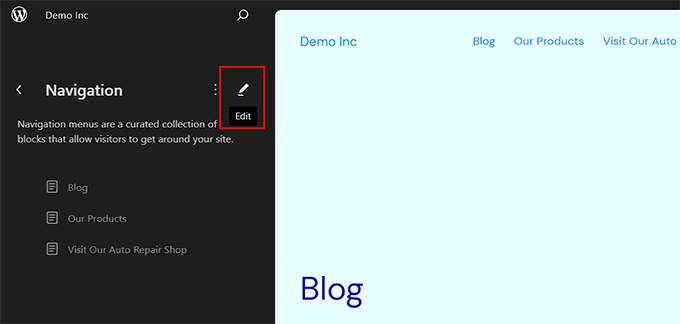
Spowoduje to uruchomienie edytora całego witryny na ekranie, gdzie możesz kliknąć ikonę „+”, aby dodać element menu nawigacyjnego.
Teraz otworzy się okno dialogowe, a Ty możesz wybrać opcję z menu rozwijanego.
Jeśli jednak chcesz dodać niestandardowy link, możesz dodać etykietę i adres URL dla elementu menu nawigacyjnego w panelu bloków. Możesz również dodać opcję wyszukiwania do swojego menu.
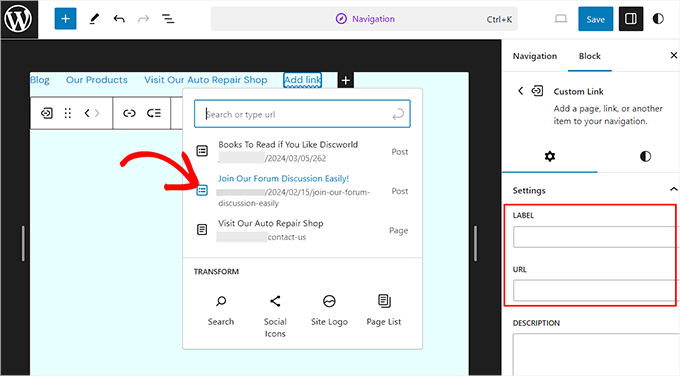
Po dodaniu elementu przełącz się na zakładkę „Style” w kolumnie po prawej stronie.
Teraz możesz zmienić typografię, wygląd, wysokość, odstępy, wielkość liter i dekorację tekstu dla swoich elementów menu.
Możesz również dodać podmenu, klikając jego ikonę na pasku narzędzi bloku.
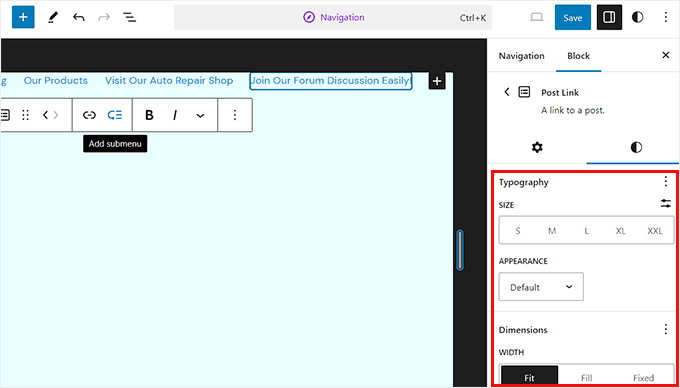
Po zakończeniu możesz podglądnąć zmiany, aby zobaczyć, jak menu wygląda w czasie rzeczywistym. Następnie nie zapomnij kliknąć przycisku „Zapisz” na górze.
Dodawanie menu WordPress do pasków bocznych i stopek
Nie musisz ograniczać się do lokalizacji wyświetlania dla swojego motywu. Możesz dodawać menu nawigacyjne w dowolnym obszarze, który używa widżetów, takim jak pasek boczny lub stopka.
Po prostu przejdź do Wygląd » Widżety, a następnie kliknij przycisk „Dodaj blok” (+) u góry i dodaj „Menu nawigacyjne” blok widżetu do swojego paska bocznego.
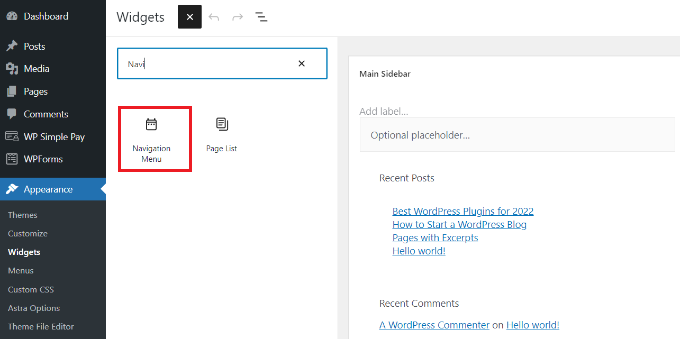
Następnie dodaj tytuł dla widżetu i wybierz odpowiednie menu z listy rozwijanej „Wybierz menu”.
Po zakończeniu kliknij przycisk „Aktualizuj”.

Oto przykład niestandardowego menu stopki WordPress zbudowanego na stronie naszego założyciela, Syeda Balkhi.

Dalsze możliwości menu nawigacyjnych
Jeśli chcesz stworzyć naprawdę epickie menu z mnóstwem linków, mamy samouczek na temat jak stworzyć mega menu w WordPress.
Pozwala to na stworzenie rozwijanego menu z wieloma elementami, w tym obrazami.
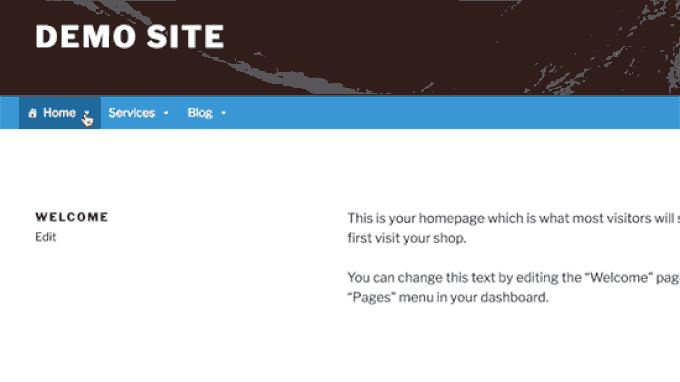
Mega menu to świetna opcja, jeśli masz dużą stronę, taką jak sklep internetowy lub strona informacyjna. Ten typ menu jest używany przez strony takie jak Reuters, Buzzfeed, Starbucks itp.
Samouczek wideo
Jeśli wolisz obejrzeć ten samouczek, obejrzyj nasz film poniżej:
Często zadawane pytania dotyczące menu WordPress
Oto niektóre z najczęstszych pytań, które początkujący zadają na temat menu nawigacyjnych WordPress.
1. Jak dodać link do strony głównej do menu WordPress?
Aby dodać stronę główną do menu nawigacyjnego, musisz kliknąć zakładkę „Pokaż wszystko” w sekcji Strony. Stamtąd powinieneś zobaczyć swoją stronę główną.
Zaznacz pole wyboru obok „Strona główna” i kliknij „Dodaj do menu”. Pamiętaj, aby zapisać zmiany.
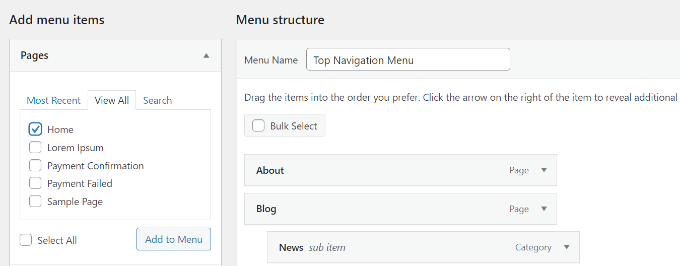
2. Jak dodać wiele menu nawigacyjnych w WordPress?
W WordPress możesz tworzyć tyle menu, ile chcesz. Aby umieścić menu na swojej stronie internetowej, musisz dodać je do jednej z lokalizacji menu motywu lub do obszaru widżetu, tak jak pokazaliśmy powyżej.
Jeśli chcesz dodać wiele menu nawigacyjnych do swojej witryny WordPress, najpierw utwórz menu, postępując zgodnie z naszym powyższym samouczkiem.
Aby umieścić je na swojej witrynie, kliknij zakładkę „Zarządzaj lokalizacjami”.
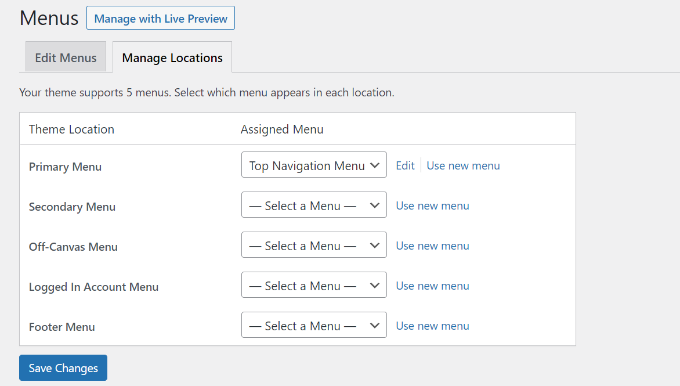
Stąd możesz wybrać, które menu chcesz wyświetlić w lokalizacjach menu dostępnych w Twoim motywie.
Jeśli chcesz dodać nową lokalizację menu do swojej witryny, zapoznaj się z naszym samouczkiem jak dodać niestandardowe menu nawigacyjne do motywów WordPress.
Mamy nadzieję, że ten artykuł pomógł Ci dowiedzieć się, jak dodać menu nawigacyjne w WordPress. Możesz również zapoznać się z naszymi poradnikami na temat stylizowania menu nawigacyjnych w WordPress oraz tworzenia przyklejonego, pływającego menu nawigacyjnego w WordPress.
Jeśli podobał Ci się ten artykuł, zasubskrybuj nasz kanał YouTube po samouczki wideo WordPress. Możesz nas również znaleźć na Twitterze i Facebooku.





Lindsey
Dziękuję za te instrukcje, bardzo pomocne! Mam pytanie, które moim zdaniem odnosi się do mojego menu, ale nie jestem do końca pewna. Kiedy klikam na pozycję menu na stronie głównej, adres strony dodaje „aboutme” między głównym adresem a stroną menu. Nie mam niczego o nazwie „o mnie” na mojej stronie. Nie rozumiem, dlaczego do każdej strony dodawana jest ta dodatkowa informacja. Czy masz jakieś sugestie, jak usunąć tę informację „aboutme”?
hans
Dziękuję.
Nauczyłem się wiele wiedzy.
Karen
Cześć. Używam Ocean WP i Elementora.
Mam zorganizowane menu, ale na jednej z moich sekcji rozwijanych menu zagnieżdżonych chcę, aby PIERWSZA kategoria NIE była połączona ze stroną (próbowałem usunąć link, ale mi się nie udało).
Zagnieżdżona sekcja wygląda następująco: TERAPIA (na górze)>Indywidualna>Grupowa
Nie chcę, aby TERAPIA prowadziła do strony, jest pusta, to chyba tylko kategoria. Robiłem to na mojej poprzedniej stronie, ale za nic nie mogę sobie przypomnieć jak!
Stworzyłem „stronę” o nazwie Terapia, aby pojawiła się w opcjach menu… pomóż mi Obi-Wan Kenobi, jesteś moją jedyną nadzieją!
Dr Karen
Wsparcie WPBeginner
Cześć Karen,
Dodaj swój górny link Terapia jako „Niestandardowy link”. W polu adresu URL wpisz znak # i kliknij dodaj do menu. Dostosuj jego pozycję w menu, a następnie kliknij przycisk Zapisz menu.
Admin
Eric Wenocur
Aha, tak się to robi! Dzięki, świetne tutoriale!
Wsparcie WPBeginner
You’re welcome, glad you like our content
saurabh
Witam,
Używamy dwupoziomowego systemu menu (tj. menu głównego/górnego i menu podstawowego/drugorzędnego) na naszych stronach internetowych. Menu górne/główne nie pojawia się na stronie mobilnej.
Jeden z naszych klientów chce, aby oba menu były widoczne na stronie mobilnej. Czy macie jakieś sugestie, jak to zrobić?
(Strona internetowa działa na motywie Newspaper, jeśli to coś pomoże.)
Ahmed
Załóżmy, że chcę opublikować wiele artykułów związanych z Androidem. Czy powinienem utworzyć stronę Android lub kategorię Android w moim menu WP.
Wsparcie WPBeginner
Cześć Ahmed,
Kategorie lepiej nadają się do sortowania treści według różnych tematów. Możesz dodać kategorię do menu nawigacyjnego swojej strony internetowej, a następnie wyświetli ona wszystkie posty przypisane do tej kategorii.
Admin
Lerissa
Cześć – Dziękuję za udostępnienie tego.
Nie mam żadnych elementów w sekcji Strony, co jest dziwne, ponieważ moja strona ma ich kilka. Czy źle skonfigurowałem jakieś ustawienie?
Lerissa
Wsparcie WPBeginner
Cześć Lerissa,
Co się dzieje, gdy klikniesz „Zobacz wszystkie” w sekcji strony?
Admin
Tom
Dziękuję za tę ilustrację.
Manish Ransubhe
cześć panie
dziękuję, założyłem nowego bloga WordPress i utknąłem na menu, nie wiem jak dodać menu, dzięki za ten użyteczny post i Twoja strona pomogła mi uruchomić moją stronę internetową.
Wsparcie WPBeginner
Cześć Manish,
Cieszę się, że ten przewodnik okazał się pomocny. Możesz również zasubskrybować nasz Kanał YouTube po samouczki wideo WordPress.
Admin
Cyndi Jarvis
Cześć i dziękuję za wsparcie. Mam prawie ukończoną stronę internetową, dość prostą, ale chcę połączyć pozycje menu ze stroną, na której znajduje się odpowiedni tekst, i w jakiś sposób móc odesłać użytkownika z powrotem do menu głównego za pomocą przycisku "Wstecz". Czy możecie mi pomóc.
Dziękuję
Wsparcie WPBeginner
Cześć Cyndi,
Powyższy samouczek pozwala na tworzenie linków do stron i dodawanie ich do menu nawigacyjnych. Wygląda na to, że chcesz czegoś nieco innego, czy możesz podać więcej szczegółów?
Admin
cyndi
Dziękuję za próbę pomocy. Nie szukam niczego niezwykłego w moim menu na stronie internetowej. Mam elementy menu ustawione jako Strona główna, O nas, Usługi, Kontakt. Nazwa menu to Pierwsze Menu i jest ustawiona jako podstawowe. Dzieje się tak, że klikam na Strona główna, a strona miga, ale nigdzie nie przechodzę. Dzieje się tak ze wszystkimi elementami menu, na które klikam. Czy masz jakieś sugestie, co ustawiłem nieprawidłowo?
Dziękuję
Wsparcie WPBeginner
Cześć Cyndi,
Możesz spróbować tego. Przejdź do strony Wygląd » Menu i kliknij Utwórz nowe menu. Następnie postępuj zgodnie z instrukcjami w artykule, aby utworzyć nowe menu, dodając swoje strony z lewej kolumny do prawej. Po tym wybierz lokalizację dla swojego menu „Główne”, a następnie kliknij przycisk Zapisz menu.
Jeśli to nie rozwiąże Twojego problemu, przejrzyj swoją stronę internetową z domyślnym motywem. Jeśli Twoje menu nawigacyjne działa zgodnie z oczekiwaniami z domyślnym motywem, to może być jakiś problem z Twoim obecnym motywem. Mam nadzieję, że to pomoże.
Admin
Regina Clarke
To było bardzo pomocne i działało pięknie na moim laptopie. Ale na moim iPhonie kategorie podmenu, które umieściłam w moim menu Blog (które wszystkie wyświetlają się jako wcięte, tak jak powinny), zawierają również opis kategorii, który stworzyłam. Na moim laptopie pojawia się to na stronie archiwum dla każdej kategorii, ale na telefonie pojawia się w rozwijanym menu, co sprawia, że wszystko wygląda niechlujnie. Czy jest sposób, aby stworzyć jeszcze jedno wcięcie tylko dla opisów pod każdą kategorią, skutecznie zagnieżdżając trzy poziomy?
Bardzo dziękuję za wszelkie sugestie.
Jillian
Cześć, utworzyłam zagnieżdżone menu, które wygląda świetnie w wersji na komputery, ale kiedy przechodzi do wersji mobilnej, wszystko, co jest zagnieżdżone, jest wyświetlane w menu naraz! Tworzy to bardzo długą stronę menu. Mam responsywny motyw i nie jestem pewna, czy można to naprawić.
Amber Shock
Dziękuję za tak łatwy do śledzenia film. Bardzo mi pomógł i szybko rozwiązałem swój problem.
Bartek
Mam problemy, ponieważ WordPress nie pozwala mi już dodawać żadnych kategorii, a nawet usuwa i zmienia kolejność niektórych, które zostały dodane. Czy ktoś wie, co może być przyczyną?
Ahmed Azeem
Moja strona internetowa nie ma opcji menu głównego, drugorzędnego, ale menu głównego i stopki. Chcę dodać menu górne na mojej stronie, czy możesz mi pomóc, jak dodać menu górne. Również na mojej stronie portfolio, jakiekolwiek elementy dodaję, nie są wyświetlane, więc proszę o pomoc w tej sprawie. Z góry dziękuję.
Jan
Myślałem, że to wyjaśnienie, jak dodać menu nawigacyjne na stronie WordPress, ale brakuje kluczowego kodu, aby faktycznie dodać je do strony. To najgłupszy tutorial (lub tytuł artykułu), jaki kiedykolwiek widziałem.
Wsparcie WPBeginner
Cześć John,
Możesz zapoznać się z naszym tutorialem na temat tego, jak dodać niestandardowe menu nawigacyjne w WordPress.
Admin
Shibani
Mam stronę, na której chcę wyświetlić niestandardowe menu, które jest kategorią – np. podróże. Działa dobrze, ale wyświetla się – Kategoria – Podróże nad postami. Jak mogę to ukryć? Używam wordpress.com i darmowego planu.
Prachi
Załóżmy, że moja strona to example.com
Chcę utworzyć zakładkę o nazwie DOM i umieścić ją w menu.
Za każdym razem, gdy tworzę ten DOM, adres URL nie akceptuje example.com
Staje się example.com/home.
Co mam zrobić?
Wsparcie WPBeginner
Cześć Prachi,
WordPress ma już menu nawigacyjne, z którego możesz skorzystać. Na ekranie menu nawigacyjnych kliknij strony, a następnie kliknij Zobacz wszystkie. Tam zobaczysz wszystkie swoje strony i pozycję o nazwie Strona główna. Wybierz stronę główną, a następnie kliknij przycisk dodaj do menu.
Admin
Jan
Postępowałem zgodnie z powyższą instrukcją. Moje menu jednak nie pojawia się na żadnej ze stron witryny. Czy mogę prosić o wskazówki?
Jan
Haitham Alnaqeb
Próbowałeś różnych motywów? Czasami używane motywy nie obsługują niektórych z tych funkcji.
Ike Ezeani
Utworzyłem drugie menu rozwijane, ale kiedy klikam główne menu, widzę menu rozwijane, ale przenosi mnie na pustą stronę. Proszę o pomoc.
Stephen B
Witam,
Kiedy loguję się do mojego WordPressa, moje menu edycji wygląda zupełnie inaczej i mam znacznie trudności z dodawaniem menu i dostosowywaniem mojej witryny z tego powodu. Czy możesz mi pomóc?
Malkeet
Cześć, dzięki za miłe i szczegółowe wyjaśnienie dodawania menu, ale jak to menu nazwać????
Husnaa
Dzięki za pomoc.
Pomagaj innym.
Lucy
Cześć, mam spore problemy z nawigacją na stronie klienta i nie wiem, jak wyjaśnić, czego potrzebuję. Kiedy klikniesz element menu najwyższego poziomu, chcę, aby otworzyło się dodatkowe menu poniżej. Każdy element najwyższego poziomu będzie miał inne podmenu, które pozostanie aktywne, gdy jesteś w tym obszarze witryny.
Tak jak na tej stronie
Kiedy klikniesz na „Commercial Solar”, pojawia się kolejne menu, które pozwala przeglądać obszar energii słonecznej dla firm. Górne menu pozostaje zaznaczone przez cały czas.
Każda pomoc, którą możesz zaoferować, będzie wspaniała! Dzięki Lucy
Wsparcie WPBeginner
Cześć Lucy,
Zapoznaj się z naszym artykułem na temat dodawania pozycji menu bez linkowania do strony.
Admin
David Blaska
Chcę połączyć moje strony z nagłówkami na stronie głównej, które podsumowują te strony. Jak to zrobić? (Np. „Nasza Historia”, „Kim Jesteśmy” itp.) Mam stronę dla każdego z nich, ale mały opis na stronie głównej. Chciałbym, aby odwiedzający klikali w nagłówek każdego z nich.
Michael
Cześć, potrzebuję, aby moje główne okno nawigacyjne „wypychało się w górę”, a nie „rozwijało w dół”. Używam Google Doubleclick Ad Exchange do reklam displayowych i twierdzą oni, że moje menu rozwijane może powodować fałszywe kliknięcia w reklamy. Czy jest jakiś sposób, abym mógł sprawić, by się wypychało?
Emma
Bardzo dziękuję za to, próbowałem dowiedzieć się, jak tworzyć menu rozwijane, to naprawdę pomogło!
isa alshabany
Cześć
Jestem początkujący, nie profesjonalista. Używam szablonu motywu i możesz to zobaczyć na mojej stronie.. Mam menu arabskie.. Potrzebuję stworzyć pod nim menu angielskie, aby angielskojęzyczni użytkownicy mogli uzyskać dostęp do angielskich stron.. Wielkie dzięki.. Isa
Haitham Alnaqeb
Myślę, że potrzebujesz wielu stron WordPress i wstawienia kodu na swojej stronie docelowej, aby przekierować odwiedzających na podstawie języka ich komputera lub kraju. Każda z tych stron będzie miała WordPress w swoim języku, ponieważ nie ma sensu, abym zalogował się na arabską stronę, która ma tylko menu po angielsku lub odwrotnie.
Steven Denger
Helo – mam subdomenę dla . Naprawdę jej nie używam, poza przechowywaniem stron. W jednym z eksperymentów użyłem kodu CSS, aby ukryć nagłówek i pasek nawigacyjny na stronie. Ale od tego czasu, gdy usunąłem kod CSS i próbowałem stworzyć menu, pasek nawigacyjny się nie wyświetla. Jestem całkiem zaznajomiony z menu WordPress i sposobem ich umieszczania. Ale po prostu nie mogę sprawić, by to się pojawiło. Wyeksportowałem niektóre strony do tej subdomeny i próbowałem stworzyć menu – ale na nic – po prostu się nie wyświetla. To właśnie mnie w WordPressie denerwuje – nigdy nie wiesz, kiedy i jak to się może zepsuć. Czy wiesz, co jest nie tak?
Paul Nye
Jak mogę dodać menu rozwijane w obszarze strony innym niż mój widżet paska bocznego?
Mary
Cześć,
Zastanawiałem się, czy niestandardowe menu zastępuje domyślne menu nawigacyjne. Jak wpływa to na istniejące menu domyślne i jego zagnieżdżenie?
Musiałbym pamiętać, aby dodać moje strony do niestandardowego menu.
Może to zabrzmieć głupio, ale wydaje mi się to bardzo skomplikowane.
Chciałem sprawić, by kilka stron było nieklikanych (jak np. „recenzje”) i podoba mi się ostateczny pomysł zagnieżdżania podrzędnego
Dziękuję za włożenie tyle energii w ten artykuł. Mary
munir
Cześć wszystkim
Jak mogę dodać menu na konkretnej stronie mojej strony internetowej? (nie potrzebuję, żeby menu pojawiało się na stronie głównej ani na pierwszej stronie)
Dziękuję wszystkim.
Asir
Musisz zainstalować i aktywować wtyczkę o nazwie (Page Specific Menu items)
Jak sprawić, by ta wtyczka działała?
Utwórz menu z wyglądu > menu
Wybierz menu, którego chcesz użyć z ustawień > PS MenuItems > Wybierz menu
Przypisz menu do lokalizacji menu z wyglądu > menu
Zaznacz elementy, które chcesz ukryć ze stron > edytuj > Elementy menu specyficzne dla strony
Wyświetl stronę, a wybrane elementy powinny zniknąć.
jenijeya
super do szybkiego zrozumienia
Lucas Phan
Hej brachu, mam do ciebie pytanie.
Jak stworzyć takie boczne menu?
Dzięki, brachu.
Wsparcie WPBeginner
Można to osiągnąć za pomocą CSS i JavaScript. Zobacz nasz artykuł o tym, jak dodać menu z panelem bocznym w motywach WordPress i spróbuj użyć go jako punktu wyjścia.
Admin
Zac
Cześć, nie widzę tych wszystkich fajnych opcji (np. przeciągnij i upuść podmenu itp.) na mojej DARMOWEJ stronie WordPress. Zastanawiam się, czy podane przez Ciebie informacje dotyczą wersji premium WordPress. Dzięki
Wsparcie WPBeginner
Cześć Zac,
Te opcje opisane w samouczku są dostępne w samodzielnie hostowanych witrynach WordPress.org. Prawdopodobnie używasz darmowej witryny WordPress.com. Zapoznaj się z naszym przewodnikiem na temat różnic między samodzielnie hostowanym blogiem WordPress.org a darmowym blogiem WordPress.com.
Bridget
Dziękuję za ten film. Wszystko wydaje się bardzo proste, ale u mnie po otwarciu WordPressa nie mam opcji wyboru „Wygląd”. Jest tylko link „Menu”. Stworzyłam menu, które pojawia się na moim blogu, ale nie mogę do niego dodać kategorii, więc menu jest w zasadzie bezużyteczne. Kiedy klikniesz na przykład na „planowanie podróży” w menu, nie przeniesie Cię do wszystkich artykułów o planowaniu podróży, tylko do czegoś losowego. Pracuję na laptopie 11-calowym i czytałam coś, co sugerowało, że problemem może być rozmiar ekranu? Jeśli tak, to nie wiem, jak sobie z tym poradzić, ponieważ podróżuję długoterminowo i to wszystko, co mam do dyspozycji. Czy masz jakieś sugestie? Naprawdę chcę, żeby menu działało, aby ludzie mogli znaleźć to, czego szukają! Dzięki! Bridget
Hatem Tahir
Witam,
pod lokalizacją menu motywu, nie widzę „Główne”, „Drugorzędne”, dlatego dodane strony nie wyświetlają się w głównym nagłówku, czy możesz pomóc.
Wielkie dzięki
sreekanth
dzięki za poradnik i jak stworzyć kategorie (jeśli wiesz, proszę stwórz film)
Deepak Raghav
Witaj Panie, chcę stworzyć więcej menu nawigacyjnych w moich motywach WordPress. Proszę powiedz mi, jak dodać więcej
Dylan
Dziękuję za spostrzeżenia, uznałem to za bardzo pomocne.
Pytanie,
Obecnie mam przycisk menu linkujący do określonego obszaru mojej strony głównej, na przykład nazwałem sekcję/kolumnę „#portfolio”, więc strona przewinie się do tej sekcji po kliknięciu przycisku menu „Portfolio”.
Mój problem polega na tym, że gdy użytkownik przechodzi do strony menu, która ładuje nową stronę, mój przycisk portfolio nie wraca do strony głównej, jest to po prostu martwy link/przycisk menu.
Mija
Świetnie – dziękuję bardzo za uczynienie tego tak zwięzłym, precyzyjnym, jasnym i zrozumiałym!!!
Rafi sultan
Naprawdę miło, każdy krok jest jasno zdefiniowany, miły materiał.
dzięki
Carrie
Dziękuję za informację! Rozumiem
1) Czy mogę tworzyć różne menu, ale czy mogę dostosować lokalizację (nawet jeśli motyw jej nie zapewnia)?
LUB
2) Utwórz dwuliniowy pasek menu w menu głównym (zamiast ukrywać te zakładki, które nie mieszczą się w jednej linii)
Używam motywu pique na wordpress.com
Wielkie dzięki i naprawdę czekam na rozwiązanie.
Na zdrowie,
Carrie
Jennifer
To mi tak bardzo pomogło! Dziękuję! Dziękuję! Dziękuję!
lisa thomson
Dziękuję za ten informacyjny poradnik, Sayed. Mam pytanie. Zmieniłem moje menu i z jakiegoś dziwnego powodu nakłada się ono na mój pasek boczny. Więc jest nierówne na górze. Czy wiesz, jak można to poprawić? Doceniam wszelkie wskazówki.
Dr.sunita karmankar
Hi, Thanks for the nice detailed explanation of adding menu, it really helped me
khalid mehmood
It really helped. thanks.
thanks.
Laxmikant Bhumkar
Doskonałe informacje w menu nawigacyjnym. Bardzo łatwe do nauczenia.
Chirag
Really nice. Go it very easily. Thank you a lot!
You Rock
pinku
bardzo bardzo przydatne informacje… teraz łatwo stworzyć menu nawigacyjne
dzięki wielkie
Sheryl Roger
Doskonały materiał. Każdy krok jest zdefiniowany tak jasno, że nawet nowicjusz może go zaimplementować bez żadnych trudności. Dziękuję za udostępnienie takiego materiału, ponieważ będzie on bardzo pomocny dla początkujących w tworzeniu stron internetowych.
Francisco
Świetny artykuł.
Dzięki!